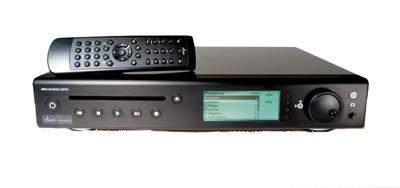Olive

In one sense the Symphony is really just a high-quality CD player with benefits - lots of them. Its slick, slot-loading drive plays CDs or rips and stores them on its 80-gigabyte (GB) internal hard drive in a choice of formats from lossless FLAC to highly compressed MP3 (Olive will rip your CDs for you - for a fee - if you're too busy). Symphony can also burn audio CDs with music stored on the hard drive. Finally, Symphony can distribute its content to your home network via standard Ethernet cabling or wirelessly using its built-in 802.11g Wi-Fi capability. It can stream to as many as five remote rooms at once depending on the encoding format and bit rate of the music. Each room must be equipped with a compatible Ethernet or Wi-Fi "client" - such as Olive's soon to be released PDA-sized Sonata ($199) - that will allow you to select music from Symphony and route it to a local music system. Symphony's line outputs are volume-controllable via its supplied remote, so for a stereo setup all you really need are a power amp and speakers (or a pair of self-powered speakers).
Symphony can integrate with Apple's iTunes music-library software on Macs or PCs and is accompanied by Olive's proprietary Playlist software for Macs only (requires OS X 10.4 or higher). Playlist lets you add, edit, and display extensive composer, title, performer, and other information on classical or other music selections (key info appears on Symphony's LCD during play), and its built-in Web browser lets you view music-dictionary entries and other relevant Web sites in real time.
SETUP Rear-panel connections include analog stereo audio outputs and inputs (Symphony can also rip from a line-level analog source), optical and coaxial digital outs, and a quartet of RJ-45 Ethernet jacks for wired connections to your home network or directly to Sonata clients or other Symphony servers - no computer-based home network required. There's a small plug for the supplied Wi-Fi antenna and a pair of USB jacks, which directly accept an MP3 player on the off chance you don't have a computer.
Symphony found my wireless home network without a hitch and configured itself (same thing when I later tried a wired Ethernet connection). It showed my Mac's iTunes music library in its LCD window, and I could browse the listings and select items in compatible formats for playback - except for songs purchased from the iTunes Music Store, which were blocked even though the Olive otherwise plays MPEG-4 and AAC files. You can drag and drop files from a Mac or PC onto the Olive's hard drive, though not the reverse. Upon loading a new CD, Symphony queries the Gracenote database for track, title, and artist info, which dutifully comes up within a moment or two. Symphony's RJ-45 ports even function as an Ethernet switch, so I was able to daisy-chain connection to my TiVo. (Symphony's networking functions are extensively addressable via an "Expert Mode" - definitely not for the clueless!) I wanted to check out the Olive's native sound quality, so I connected both its analog and digital audio outputs to my system.






























































